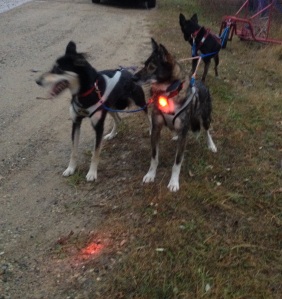Training for a team or individual athletic is a journey. Every sport has their goals, expectations, and pre-season training routines. At our school I coached the middle school cross country runners this fall beginning with our pre-season conditioning and learning their individual paces.
For the musher and their team of dogs, the fall season of training will begin when the temperatures drop below 50′ normally. The musher ( coach ) makes a commitment to be diligent to prepare their team for the season. For the dogs, it is what they love to do- run! It is a time for the dogs to build muscle, strength, and endurance.
For my team I take advantage of the opportunity to run near home and in the UP of Michigan. we have wooded trails or use seldom traveled gravel roads to run using the non- motorized Risdon Rig, that is great for training a small team. The blending of my dogs with the female yearlings at Nature’s Kennel in McMillan happens on the weekends. It is an opportunity to train the larger 12-14 dog team with a quad.
Fall training is can be accomplished with different schedules and routines but it is the journey that builds and grows throughout the winter season










